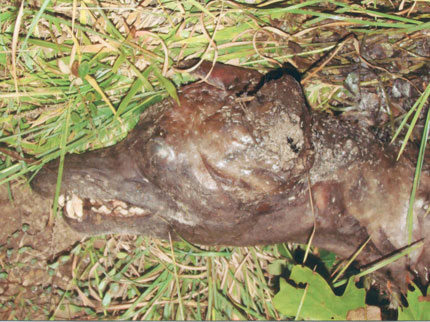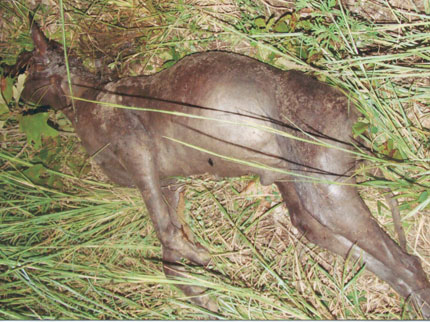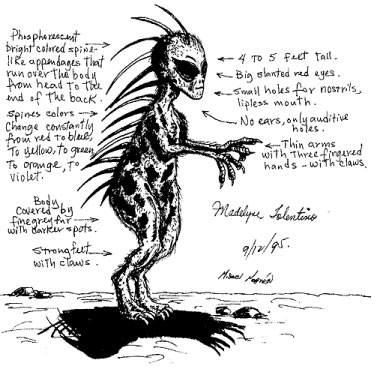Doggone More: An Okie “Chupacabras”
Posted by: Loren Coleman on September 3rd, 2009
An Oklahoma television station, “News On 6” was sent the above photos by a “viewer who requested her name not be used.”
She told the station the two pictures showed a dead Chupacabras in Stilwell, Oklahoma, a town about 100 miles southeast of Tulsa.
You decide. What do you think it is?
The traditional Chupacabras:
Now for your musical interlude…as you ponder this latest Okie labeled a “Chupacabras.”
As you will recall, ”More” is the theme song to the 1962 Italian film Mondo Cane (“A Dog’s World”).
Thanks to many people too numerous to name who sent along links and more regarding the Texas and Oklahoma “Chupacabras” stories and videos.
About Loren Coleman
Loren Coleman is one of the world’s leading cryptozoologists, some say “the” leading living cryptozoologist. Certainly, he is acknowledged as the current living American researcher and writer who has most popularized cryptozoology in the late 20th and early 21st centuries.
Starting his fieldwork and investigations in 1960, after traveling and trekking extensively in pursuit of cryptozoological mysteries, Coleman began writing to share his experiences in 1969. An honorary member of Ivan T. Sanderson’s Society for the Investigation of the Unexplained in the 1970s, Coleman has been bestowed with similar honorary memberships of the North Idaho College Cryptozoology Club in 1983, and in subsequent years, that of the British Columbia Scientific Cryptozoology Club, CryptoSafari International, and other international organizations. He was also a Life Member and Benefactor of the International Society of Cryptozoology (now-defunct).
Loren Coleman’s daily blog, as a member of the Cryptomundo Team, served as an ongoing avenue of communication for the ever-growing body of cryptozoo news from 2005 through 2013. He returned as an infrequent contributor beginning Halloween week of 2015.
Coleman is the founder in 2003, and current director of the International Cryptozoology Museum in Portland, Maine.













(Sigh). Another dog/coydog with a really bad case of mange. Or just possibly naturally hairless, but still obviously a dog/coydog. Can someone explain to me why seemingly knowledgeable people (taxidermists, photojournalists, farmers and ranchers, law enforcement officers, etc.) can’t look at a dead dog and recognize it as a dead dog?
It is a dead canid, possibly with mange or some other skin/hair disease.
How hard is that to see? A DNA test would clear it right up.
I am amazed at the lack of common sense being portrayed. Granted I do not know what ‘breed’ of canid it is. But it is a canid.
Which, by the way, looks nothing like the drawing of the Chupacabra.
*twitches*
Seriously? The reason these goat suckers are being found so much now, is evidently due to everyone losing their common sense! Most people know better than to touch, let alone collect, a dead dog or coyote.
Doesn’t the fact that “seemingly knowledgeable people” don’t recognise the critter suggest that it’s something uncommon?
I’ve never seen a completely bald, uneven limbed coyote before. It could well be one. But I do still find it odd that several people have now spotted strange dog like animals with no fur and odd sized legs. And none of them seem to think they’re coyotes.
I have to agree with Jason, how come there hasn’t been talk of mange this bad before. Only the last couple of years has this phenomenon has occurred I never heard of it before. Then some people say “oh it’s a dog with mange isn’t it obvious” and everyone lines up behind that and now there all knowledgeable about this condition. It makes me laugh I have to tell you, why hasn’t the question “how come there are so many cases of mange this severe occurring recently?”
I mean no disrespect to anyone but think about it for a moment before you all go down the typical path.
I am not from OK or TX where most of these mangy coyote sightings have been. I am from Northwest NC, in the foothills. And I have seen mange like this in animals. Mostly pets that have not been taken care of properly. I can not say I have seen it this bad in the wild population. Have seen a really mangy fox, that looked way strange, but it wasnt that bad.
However, having personally seen mange like this, and knowing what the animal looked like before mange, and what it looked like after the severe mange; I can understand why Jason might say this. But I know personally (though you do not have to take my word for it) that animals look completely different without fur/hair. And the vets around here, wouldn’t make a big deal out of the animal in the picture above.
I have seen and read, that corpses, like these, have all been attributed (after DNA) to mangy coyotes. So the three cases that I have followed, turned out to be mangy coyotes. Odds are in my favor that this one too is a mangy canid.
However, if DNA proves me wrong, I will be the first one to admit that I jumped to a conclusion.
“I have to agree with Jason, how come there hasn’t been talk of mange this bad before. Only the last couple of years has this phenomenon has occurred I never heard of it before.”
Lumberjack that is fairly easy. Because no self respecting journalist or news station would have run these kinds of stories several years ago. We are now into tabloid news, journalists are getting lazy and they look for titillating items that gain ratings. The phenomenon of odd looking animals in the woods has always been around. Forty plus years in the woods, you do see these kinds of things though they are rare. I’ve found dead dessicated dogs, coyotes, foxes and other animals that I could have claimed as “monsters” they looked so strange. But I simply would have been a laughingstock. Now this stuff can you get you 15 minutes of Youtube fame. That’s the other part of the equation going on. Also I think people are looking for the unknown, looking for mystery, a little excitement in their lives. It is a diversion from a lot of bad news we hear and the generally safe and antiseptic lives many people lead. Communications are instant and three or four of these animals a year gets put on the Internet and one gets the impression these things are new or are becoming fairly common. Misperception.
As far as “knowledgeable people” goes, I wish I had a dollar for every “rattlesnake” that I dealt with and $1000 for the “cougar” that turned out to be a red fox. In all these cases, the observer positively “knew what they saw” and “looked it up in the wildlife guide”. Only about 9 out of 10 times they were wrong.
Are there unknown animals out there? Never say never. I think the oceans particularly will yield some surprisingly large unknown animals yet and maybe even the remote rain forests of the globe. (But those are diminishing every day and with it the chances of discovering any large unknown animals) Some animals are showing up in areas where they have been absent for 100+ years (bears, alligators, mountain lions and wolves)
The wide variety of domestic dogs is literally endless and mix some of those odd combinations with coyotes and you do get odd looking critters. Let one be dead on the side of a road for awhile and its appearance really becomes “other worldly”. In that sense, these animals may be cryptids. But the canids as Chupas thing is just a bunch of media hype, filler for the local paper and news anchors. It’s getting silly.
Having found and buried alot of dead dogs, I firmly believe that we have, what looks like, a long dead chihuahua. Notice the long tail. It looks to have been dead for a few days, possibly a week or more, because of the bloating and the hair loss. One of the front limbs looks to be mangled or possibly a defect.
The reason I say chihuahua is because:
1) The ears and long skinny tail. and
2) Notice the size of the grass blades in relation to the body.
The reason the limbs look totally uneven is the photographer took the pic at an angle from the back corner.
On a funny note though, when I first saw it, “Kangaroo” popped into my head, lol.